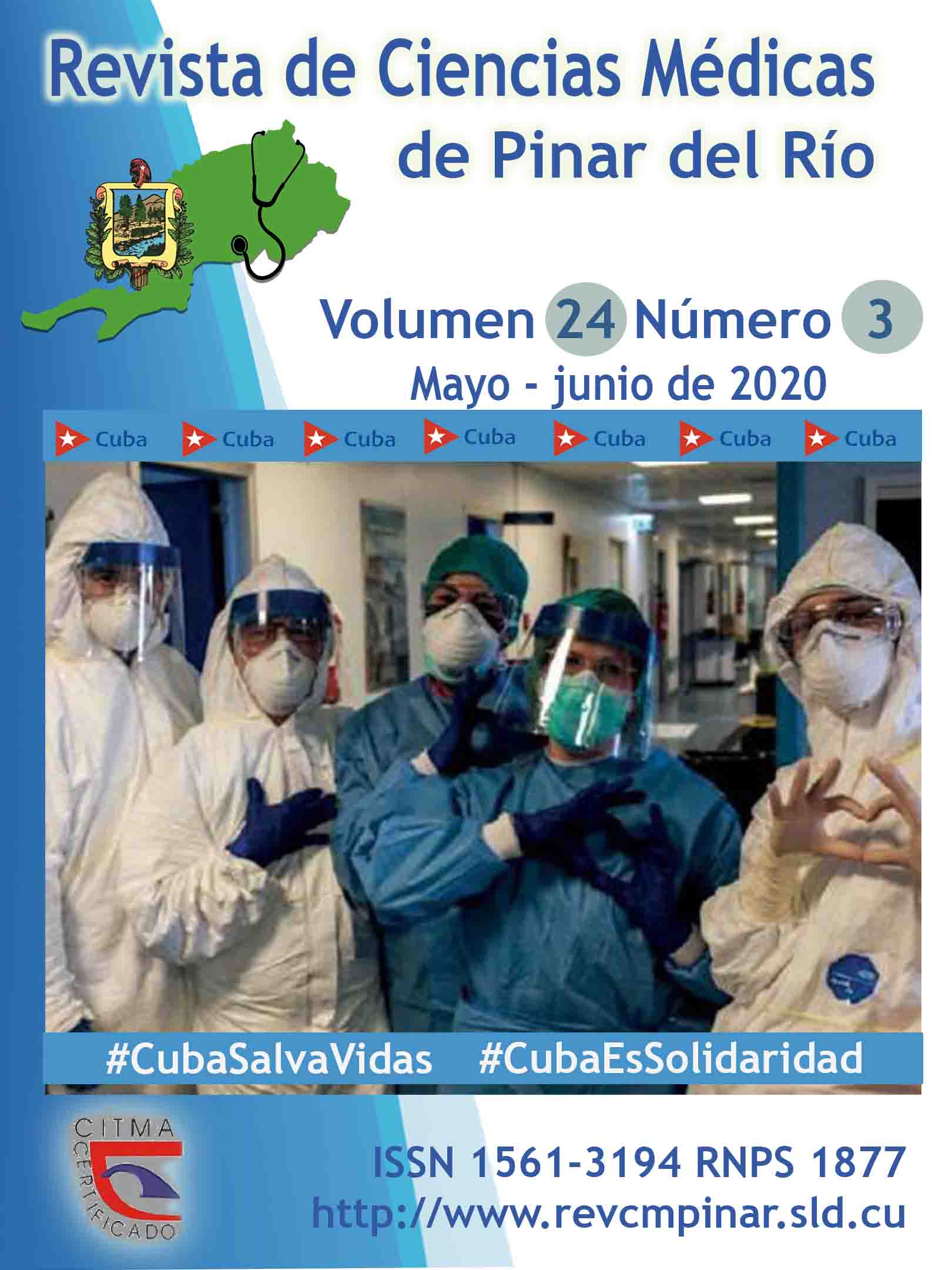Evaluation of the initial APACHE II score in the Emergency Intensive Care Unit
Keywords:
APACHE II, EMERGENCIES, MORTALITYAbstract
Introduction: the use of prognostic mortality scores is a very useful tool in intensive care units, allowing a better approach to medical care.
Objective: to determine the usefulness of APACHE II in the Emergency Intensive Care Units at Celia Sanchez Manduley General Hospital.
Methods: an observational, analytical and cross-sectional study was carried out in the period from April to June 2018 with 68 patients. To identify the statistically significant differences between the categories of some of the variables studied, the Chi-square statistic was used, with p <0.05 being considered significant. To calculate the discrimination, the area under the curve with 95% confidence intervals was analyzed, and the calibration was also examined through the standardized mortality ratio.
Results: cerebrovascular diseases prevailed (27.9 %), 35 patients (51.4%) reached the APACHE II ≥15 scores, intermediate care unit was the destination service that admitted the most patients (39.7%). Eighteen (18) patients died, of them 14 were admitted having APACHE II ≥15 scores (77.7 %, p=0.009). The mortality rate observed was 18, the standardized ratio of mortality reached 1.04, and the area under the curve was 0.679 p=0.025 (IC: 0.538-0.820).
Conclusions: APACHE II can be a useful tool in intensive care units, allowing a better approach to medical care.
Downloads
References
1. Caballero López A, Domínguez Perera MA, Pardo Núñez AB, Abdo Cuza AA. Terapia intensiva. La Habana, Cuba: Editorial Ciencias Médicas; 2019. p. 55-57.
2. Alvear Vega S, Canteros Gatica J. Evaluación del desempeño del APACHE II y SAPS III, en una unidad de cuidados intensivos. Rev. Salud Pública [internet]. 2018 [citado 2 Abril 2019]; 20(3):373-377. Disponible en:https://www.scielosp.org/article/rsap/2018.v20n3/373-377/
3. Godínez Ortiz LE, Ranero Meneses JL. Predictores de mortalidad en pacientes críticamente enfermos: Correlación de la Escala APACHE II y APACHE IV. Revista de Medicina Interna de Guatemala [internet]. 2017 [citado 5 Abril 2019]; 20(1):7-12. Disponible en: http://asomigua.org/wp-content/uploads/2017/05/art-1-.pdf
4. Rocchetti NS, Egea-Guerrero JJ, Ruiz de Azúa-López Z, Martín-Villén L, Rodríguez-Rodríguez A, Vilches-Arenas Z, et al. APACHE II y SAPS II como predictores de evolución a muerte encefálica en pacientes neurocríticos. REV NEUROL [internet]. 2018 [citado 2 mayo 2019]; 67(4): 121-128. Disponible en: https://www.neurologia.com/articulo/2018077
5. Pérez Cabrera D, Suárez Méndez BE, Valdés Suárez O, Vázquez Vázquez L, Corrales Castañeda Y, Valdés Gómez I. Valoración del APACHE II inicial como predictor de mortalidad en pacientes ventilados. Rev Cub Med Int Emerg [internet]. 2017 [citado 2 noviembre 2018]; 16(2):80-92. Disponible en: http://www.revmie.sld.cu/index.php/mie/article/view/253/html_103
6. Hernández Oliva M, Merlán Pérez AI, Álvarez González R. Factores pronósticos de pacientes con sepsis en cuidados intensivos. Rev Cub Med Int Emerg [internet]. 2018 [citado 28 diciembre 2019]; 17(1):30-41. Disponible en: http://www.revmie.sld.cu/index.php/mie/article/view/278/html_135
7. Knaus WA, Draper EA, Wagner DP, Zimmerman JE. APACHE II: a severity of disease classification system. Crit Care Med 1985; 13(10): 818-829.
8. Álvarez Flores YB. Morbilidad y mortalidad en la Unidad de Cuidados Intensivos Emergentes. Hospital Universitario Arnaldo Milián Castro. Rev. PortalesMedicos.com [Internet]. 2014, Feb. [acceso: 20 jun. 2016 ].Disponible http://www.revista-portalesmedicos.com/revista-medica/morbilidad-y-mortalidad-en-la-unidad-de-cuidados
-intensivos-emergentes.
9. Vásquez-Alva Rolando, Amado-Tíneo José, Ramírez-Calderón Fanny, Velásquez-Velásquez Rafael, Huari-Pastrana Roberto. Sobredemanda de atención médica en el servicio de emergencia de adultos de un hospital terciario, Lima, Perú. An. Fac. med. [Internet]. 2016 Oct-dic [citado 2019 Jul 08] ; 77( 4 ): 379-385. Disponible en: http://www.scielo.org.pe/scielo.php?script=sci_arttext&pid=S1025-55832016000400010&lng=es.
10. Huamán P, Mosquera K, Cieza J. Supervivencia de pacientes hospitalizados en la emergencia de un hospital general nivel III de Lima-Perú. Acta Med Peru. [Internet]. 2018 [citado 28 diciembre 2019];35(1):36-42. Disponible en:
11. Organización Mundial de la Salud. Las 10 causas principales de defunción en el mundo [Internet]. Ginebra: OMS; c2017 [citado el 6 de febrero de 2017]. Disponible en: http://www.who.int/mediacentre/factsheets/fs310/es/index1.html
12. Mezquia de Pedro N, Soler Morejón C, Tamargo Barbeito TO, Olmo Mora J. Acute Physiology and Chronic Health Evaluation Score II, estratificación de riesgo en la insuficiencia cardiaca. Rev Cub Med Int Emerg [internet]. 2018 [citado 28 diciembre 2019]; 17(4). Disponible en: http://www.revmie.sld.cu/index.php/mie/article/view/384/html_185
13. Sebastián Rocchetti N, Horacio Bagilet D, Settecase CJ, Quaglino M. Desempeño de los puntajes APACHE II y SAPS II para calcular la razón de mortalidad estandarizada en una Unidad de Cuidados Intensivos polivalente de la Argentina. MEDICINA INTENSIVA [internet]. 2016 [citado 5 Abril 2019]; 33(1). Disponible en: http://revista.sati.org.ar/index.php/MI/article/view/437/369
14. Hanley JA, McNeil BJ. derivadas de los mismos casos. Radiology 1983; 148: 839-43.
15. Varghese YE, Kalaiselvan MS, Renuka MK, Arunkumar A S. Comparison of acute physiology and chronic health evaluation II (APACHE II) and acute physiology and chronic health evaluation IV (APACHE IV) severity of illness scoring systems, in a multidisciplinary ICU. J Anaesthesiol Clin Pharmacol [Internet]. 2017 [citado 2019 el 27 de mayo]; 33(2): 248-53. Disponible en: http://www.joacp.org/article.asp?issn=0970-9185;year=2017;volume=33;issue=2;spage=248;epage=253;aulast=Varghese
Downloads
Published
How to Cite
Issue
Section
License
Authors who have publications with this journal agree to the following terms: Authors will retain their copyrights and grant the journal the right of first publication of their work, which will be publication of their work, which will be simultaneously subject to the Creative Commons Attribution License (CC-BY-NC 4.0) that allows third parties to share the work as long as its author and first publication in this journal are indicated.
Authors may adopt other non-exclusive license agreements for distribution of the published version of the work (e.g.: deposit it in an institutional telematic archive or publish it in a volume). Likewise, and according to the recommendations of the Medical Sciences Editorial (ECIMED), authors must declare in each article their contribution according to the CRediT taxonomy (contributor roles). This taxonomy includes 14 roles, which can be used to represent the tasks typically performed by contributors in scientific academic production. It should be consulted in monograph) whenever initial publication in this journal is indicated. Authors are allowed and encouraged to disseminate their work through the Internet (e.g., in institutional telematic archives or on their web page) before and during the submission process, which may produce interesting exchanges and increase citations of the published work. (See The effect of open access). https://casrai.org/credit/



